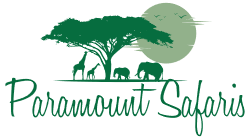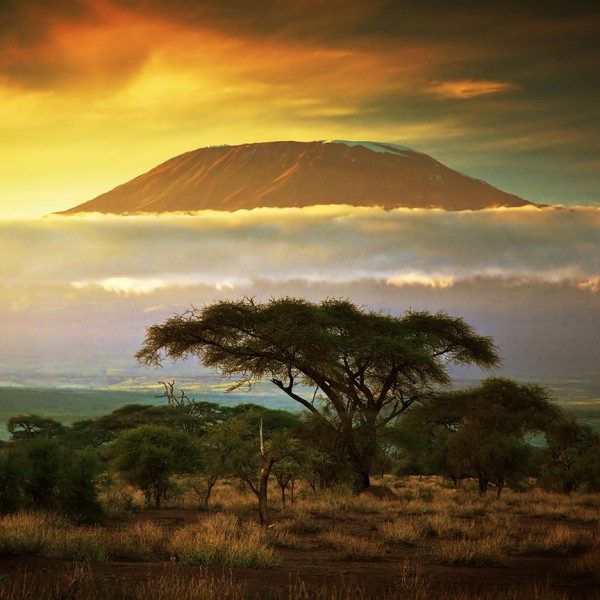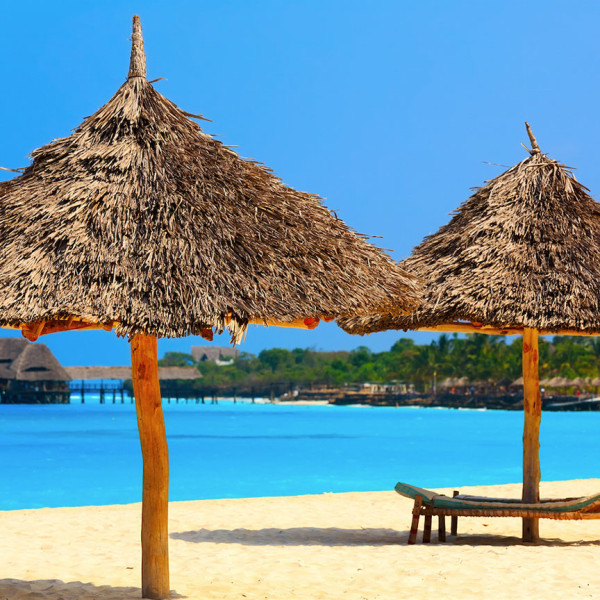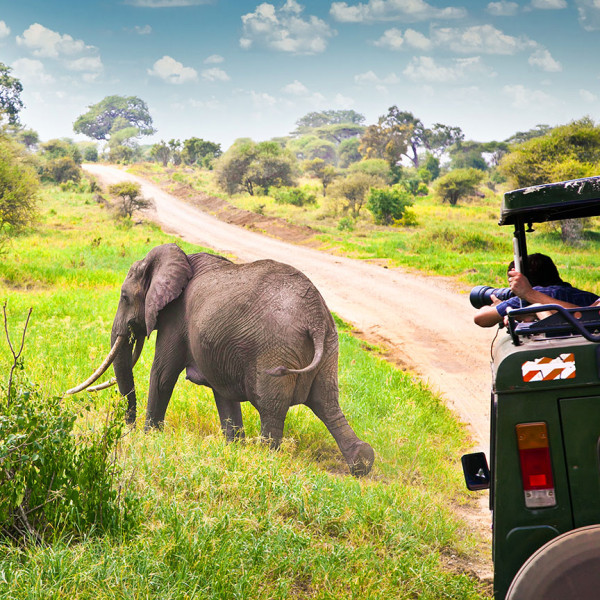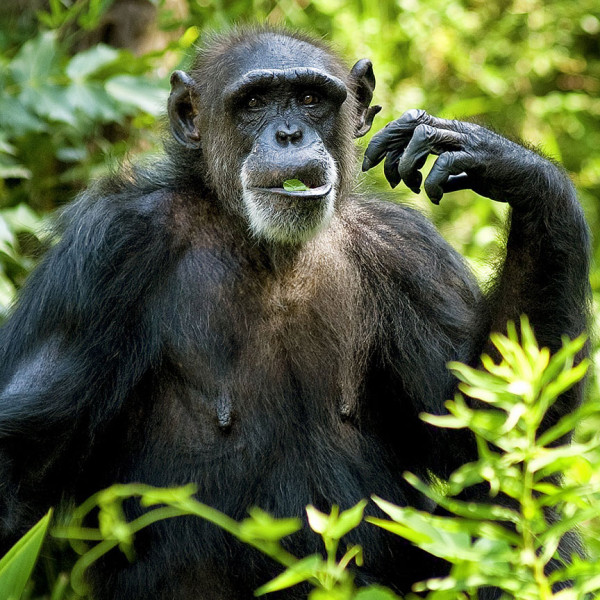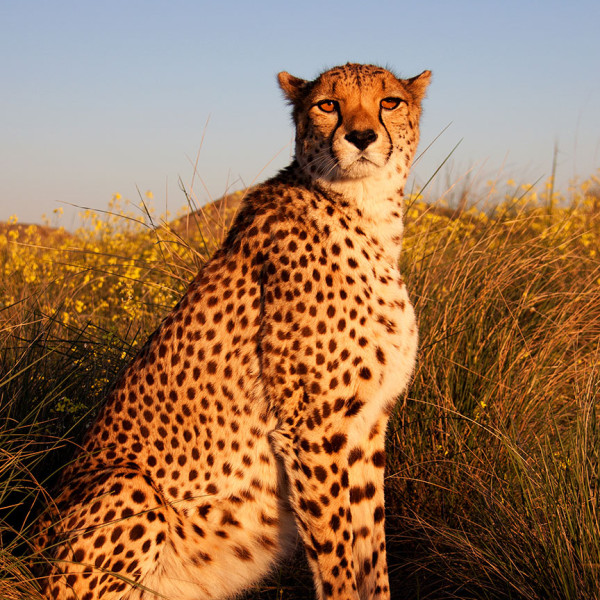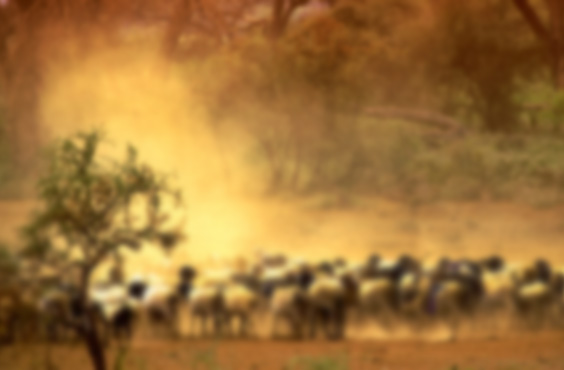
If you are looking for an amazing mountain adventure we recommend climbing Mt Kilimanjaro. It is the world’s highest free-standing, snow-covered equatorial mountain at 19, 340 feet. This place of myth and folklore watches over Tanzania like a proud father. Climbing Mt Kilimanjaro is a test of one’s abilities and has become a ‘must-do’ for traveler’s to Tanzania. The experience can truly be life changing.
Although not that technical, climbing Mt Kilimanjaro is not for the faint of heart. As the climb weaves through tropical forests around 6,000 feet, this area is usually damp or drenched with rainfall. At 10,500 feet a wide expanse of moorland extends beyond the cloud line, so here the skies are generally clear, making the sunshine intense during the days and the nights cool and clear. The climbing incline remains gentle, but thinning oxygen provides less fuel to energize the muscles and can slow the pace of walking. Climbing higher into the Alpine Desert beyond 13,000 feet is where sparse vegetation intensifies as the landscape develops into a more alpine desert. Few plant species survive beyond 16,000 feet where the landscape is mostly rock and ice.
Our expert guides do their best to ensure you reach the top when climbing Mt Kilimanjaro by providing comfort, good food and encouragement along the way. Making the summit is the goal of course, but the real reward is in taking the journey in the first place.
The centerpiece of a Paramount Safaris experience is the annual Serengeti wildlife migration. Regarded as Nature at her most extravagant, it involves hundreds of thousands of wildebeest, zebra and antelope running the gauntlet of predators as they migrate around the Serengeti and through the African ecosystem. It’s survival of the fittest as they plunge through crocodile-infested waters on their annual exodus north.
The Serengeti is one of those rare places that receives so many accolades yet manages to live up to all the hype. Our tours reveal this larger than life wildlife migration of huge predator concentrations and river crossings, where lion prides, leopard and even cheetahs can be sighted. And we introduce you to the local culture, a tribe known as the Masai.
The Serengeti is Tanzania's oldest and most popular national park, recently proclaimed a 7th world wide wonder and is famed for its annual wildlife migration of wildebeest, zebra and antelope. Yet even when the wildlife migration is quiet, the Serengeti offers arguably the most scintillating game-viewing in Africa: great herds of buffalo, smaller groups of elephant and giraffe, and thousands of eland, topi, kongoni, impala and Grant’s gazelle. Let Paramount Safaris take you there, front seat and center to experience it all.
Prices are per person and range from $1,520 to $5,250 depending on duration. For more details about itineraries and prices for our 15 tours, go to our Tour Packages page.
The famous Ngorongoro Crater Safari, where life is as abundant as anywhere on earth, is where you'll discover nature’s “Big Five”; the Lion, the Elephant, the Buffalo, the Rhino, and the Leopard. All staking their claim to superiority in nature's caldron.
The crater, which has been declared a World heritage site, is 7,500 ft above sea level, and is the largest unbroken caldera in the world. Surrounded by very steep walls rising 2,000 ft from the crater floor, this natural amphitheater measures 12 miles in diameter and 188 sq miles in area. It is home of up to 30,000 animals, almost half being wildebeest and zebra. Buffalo, Elephant, Hippo, Hyena, Jackal, Lion, Ostrich, Warthog, Bushbuck, Eland, Hartebeest, Waterbuck and huge herds of Gazelle's are common on the crater floor.
Thanks to anti-poaching patrols, the crater is now one of the few places in East Africa where visitors can be certain of seeing Black Rhino. Leopards may occasionally be spotted in the trees of the surrounding forest while Cheetah are present but rarely seen. Large herds of Giraffe live on the rim of the crater and will be seen on the drive to Olduvai Gorge and the Serengeti. Countless Flamingo form a pink blanket over the soda lakes while more than 100 species of birds not found in the Serengeti have been spotted.
Prices are per person and range from $1,520 to $5,250 depending on duration. For more details about itineraries and prices for our 15 tours, go to our Tour Packages page.
Our tours of Tanzania include the island paradise of Zanzibar which is perfect for a family beach holiday or an adult get-away. Zanzibar is a great place to enjoy cool beaches, a unique culture that only the people there can provide, eclectic music, and bold architecture of the past and present.
Travelers to Zanzibar always take in Stone Town, the vibrant and colorful island capital, a historic hub of commerce and culture. For many years Zanzibar has evoked dreams of romance and mystery. And the reality will not disappoint those who are seeking an enlightened experience.
Zanzibar is an archipelago of historic Indian Ocean islands, awash with atmosphere, intrigue and coral beaches waiting to be explored. There is a wide choice of places to stay, with rates all across the spectrum. A change of pace, with plenty to see, to do and most importantly, to discover.
As the birthplace of the Swahili, site of Sultans’ Palaces and renowned for its spice plantations, the little island republic features larger than life experiences and is a must-see for any one of our Paramount Safaris tour holidays. As the charts below indicate there are many unique activities and tours to take in during your stay. We can’t wait to show you all the riches of Zanzibar. Please contact us for more information about our Zanzibar tours, itineraries and prices.
Arusha National Park is the starting point for Paramount Safaris Northern Circuit Safaris. It sits snugly in a wide expanse of fertile volcanic land in the foothills of Mt Kilimanjaro’s little brother, Mt Meru which is much more of a technical climb than Kilimanjaro, and a great challenge for more experienced climbers.
Arusha National Park is a multifaceted jewel, often overlooked by safari tours, despite offering the opportunity to explore a diversity of habitats within a few hours. Arusha is at the heart of Tanzania's safari industry – virtually everyone visiting Tanzania’s Northern parks will travel through this town. However, Arusha is definitely more than just a safari town; it has superb views of Kilimanjaro and with a number of coffee plantations at the edge of town, it is a great place to stay for a day or two before heading out on safari.
Arusha National Park is also a great distraction for a full or half day game drive. It is very quiet and has a wide variety of animals and superb bird life. The entrance gate leads into a shadowy forest inhabited by inquisitive blue monkeys – the only place on the northern safari circuit where the acrobatic black-and-white Colobus monkey can be seen. Also a rare sighting is the leopard who seemingly hides in plain sight.
Prices are per person and range from $1,520 to $5,250 depending on duration and lodging. For more details about itineraries and prices go to our Tour Packages page.
Lake Manyara National Park offers a wilderness experience in diverse habitats, from its Rift Valley soda lake to dense woodlands and steep mountainsides. Apart from a spectacular setting, the park is well known for its unusual tree-climbing lions and the vast elephant herds it was established to protect. The scenic beauty of Manyara is the main reason to travel here and certainly deserves a visit and is best used as a soft introduction to a safari. It’s also famous for the thousands of pink flamingos around the breathtaking soda-ash Lake Manyara.
Lake Manyara is often visited for an afternoon's game drive on the way to Ngorongoro as the game concentrations are not nearly as high as surrounding parks, but there are a number of unique species that make it a good reason to safari here. Lake Manyara's tree climbing lions are the parks main attraction. A lion relaxing in an Acacia tree is an incredible site. The park is also famous for elephants and a huge number of baboons. And due to its varied landscape has an impressive range of other game including wildebeest, buffalo, hippo, zebra, warthog, waterbuck, dik-dik and impala. The birding here is very good, especially raptors.
Prices are per person and range from $1,520 to $5,250 depending on duration and lodging. For more details about itineraries and prices go to our Tour Packages page.
Tarangire National Park is located slightly off the main safari route. This park in northern Tanzania is most famous for its elephant migration, birding and quiet authentic safari atmosphere. With a game safari viewing area that is roughly ten times the size of nearby Manyara and a concentration of game that is exceptional, this Tanzania big game safari park is a little gem on the Northern safari circuit, especially if you love elephants!
Tarangire is the surprise package on the Northern circuit. Often overshadowed by the Serengeti and the Ngorongoro Crater, Tarangire has immense concentrations of game in the peak months and a fraction of the visitors that go to any of the other Northern parks. The game viewing here is superb and the atmosphere and habitat is completely different from the other parks. The concentration of animals around the Tarangire river is almost as diverse and reliable as in the Ngorongoro Crater.
Elephants are the main attraction with up to 3,000 in the park during the peak season months. Peak season also sees good numbers of wildebeest and zebra as well as giraffe, buffalo, gazelle, kudu, eland, leopard and cheetah. Overall, a superb little park that offers great value and a good option for getting away from it all.
Prices are per person and range from $1,520 to $5,250 depending on duration and lodging. For more details about itineraries and prices go to our Tour Packages page.
In the Selous Game Reserve the rivers and lakes are the lifeblood to a park that hosts phenomenal volumes of game including lion prides, Africa’s largest elephant populations, and most likely it’s largest buffalo, hippo and crocodile. It’s much quieter than the Northern parks making it a hidden gem!
This park is so vast it is impossible to count its game and that is exactly what makes it special. The Selous is untouched African wilderness and the fact that it is still easily accessible makes it one of our favorite safari locations. Home to some of Africa's best boat safaris, walking and fly camping trips, the Selous has Tanzania's greatest diversity of safari activities. It is not only a great place for the safari enthusiast but also an amazing introduction to unspoiled Africa.
The wildlife in the Selous is both resident and migratory. Lion are particularly strong here and there are large numbers of leopard. The park also hosts very good buffalo, giraffe, eland, hyena, sable, hippo, crocodile, kudu, baboon, wildebeest, zebra, impala, hartebeest, colobus and vervet monkeys. With everything going on you will have plenty to see and do in the Selous.
Prices are per person and range from $1,520 to $5,250 depending on duration and lodging. For more details about itineraries and prices go to our Tour Packages page.
Open year around the Mikumi National Park has open horizons and abundant wildlife. And the Mkata Floodplain, the popular centerpiece of Mikumi, often draws comparisons to the famous Serengeti Plains. Mikumi National Park also sits next to the northern border of Africa's biggest game reserve - the Selous. It's one of the most accessible parts of the 47,000 square mile tract of wilderness that stretches east nearly to the Indian Ocean.
Zebra and wildebeest survey their grassy kingdom – along with the lions, impala and buffalo herds that migrate across it. Giraffes forage in the isolated acacia stands along the Mkata River, areas of shade favored by Mikumi's elephants. Cris-crossed by a good circuit of game-viewing roads, the Mkata Floodplain is perhaps the most reliable place in Tanzania for sightings of the powerful eland, the world’s largest antelope. The equally impressive greater kudu and sable antelope haunt the miombo covered foothills of the mountains that rise from the park’s borders. More than 400 bird species have been recorded, with such colorful common residents as the lilac-breasted roller, yellow throated longclaw and bateleur eagle making appearances. And hippos are the star attraction supported by an ever-changing cast of waterbirds. As the fourth-largest park in Tanzania there is plenty to see.
Prices are per person and range from $1,520 to $5,250 depending on duration and lodging. For more details about itineraries and prices go to our Tour Packages page.
Gombe National Park is the smallest of Tanzania’s national parks, a fragile strip of chimpanzee habitat straddling the steep slopes and river valleys that hem in the sandy northern shore of Lake Tanganyika. This place was made famous by the pioneering work of Jane Goodall in 1960 who founded a behavioral research program that now stands as the longest-running study of its kind in the world.
The most visible of Gombe’s other mammals are also primates. A troop of beachcomber olive baboons are exceptionally friendly, while the red colobus monkeys stick to the forest canopy. The park’s 200-odd bird species range from the iconic fish eagle to the jewel-like Peter’s twinspots that hop tamely around the visitors’ center.
There's plenty to do: Chimpanzee trekking; hiking, swimming and snorkeling, a visit to the site of Henry Stanley's famous “Dr Livingstone I presume” near Kigoma. And watching the renowned dhow builders at work. After dusk, a dazzling night sky is complemented by the lanterns of hundreds of small wooden boats, bobbing on the lake like a sprawling city. Walking with the chimps in the rainforest during the day and swimming in lake Tangayika in late afternoon makes for an amazing day in Gombe.
Prices are per person and range from $1,520 to $5,250 depending on duration and lodging. For more details about itineraries and prices go to our Tour Packages page.
Ruaha National Park is located in the heart of the country and considered the 'other park' on the Southern circuit. Ruaha's relative inaccessibility has resulted in a park that takes far fewer tourists than its neighbor the Selous and far fewer than any park in the Northern circuit. The rewards of Ruaha is a park filled with wild landscapes of baobab studded hills and rocky escarpments, playing host to an excellent level of game including superb concentrations of predator wildlife; cheetah, lions, leopards and hyenas.
Ruaha is certainly a wilder park than its neighbor the Selous, and ultimately has the better game viewing, albeit at the lack of any boating safaris. Overall an incredibly rewarding place to be on safari and an amazing addition to any Tanzania safari holiday. The game viewing in Ruaha is some of the best you will find in Tanzania with very few tourists and offers superb value. This park includes elephant and buffalo herds too. It is the park's ability to provide species from east and southern Africa together that excites predator wildlife enthusiasts. What you can guarantee from Ruaha is great game in a truly wild and authentic environment that is huge and still untouched. Overall an absolutely superb and affordable place to be on safari.
Prices are per person and range from $2,750 to $5,250 depending on duration and lodging. For more details about itineraries and prices go to our Tour Packages page
Not just a chimpanzee trekking destination, Mahale National Park has an absurdly good beach with gin clear waters. And the park itself would stake its claim as one of the most interesting destinations in Africa. Mahale is located in Western Tanzania to the South of Kigoma town, it borders Lake Tanganyika – the World’s longest, second deepest and least polluted freshwater lake that harbors an estimated 1000 unique fish species.
Like its northerly neighbor Gombe, this park is home to some of the Africa’s last remaining wild chimpanzees, a population of roughly 900. Tracking the chimps of Mahale is a magical experience that must be seen to appreciated. Mahale’s chimps have been studied and habituated for more than 40 years and are well accustomed to people. Nevertheless, they are wild animals so need their space, so care and respect are the order of the day.
There are many things to do while at Mahale. There are unique animals to see like the Angola Colobus monkey (pictured), and a wide range of forest birds. Lake Tanganyika is spectacular and includes activities like snorkeling, water sports activities and just relaxing and enjoying the beach. Local sports fishermen can be seen until the setting sun ends their day. And a hike to the Park’s highest point “Nkungwe” (8,069 feet) holds mysteries untold. Mahale is one of the most unique safari destinations in Tanzania. Enjoy!
Prices are per person and range from $1,520 to $5,250 depending on duration and lodging. For more details about itineraries and prices go to our Tour Packages page.

